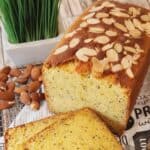Almond Butter Cake
This Almond Butter Cake is rich, nutty, and buttery-soft—the kind of treat that melts in your mouth and keeps you coming back for another slice. Chia seeds add a little crunch, and it’s easy to customize!
Servings: 8 slices
Calories: 452kcal
Equipment
- 1 baking pan 8x4 inch baking pan
Ingredients
- 180 gr sugar
- 227 gr unsalted butter
- 4 gr salt
- 5 eggs
- 195 gr cake flour
- 8 gr baking powder
- 30 gr milk powder
- 20 gr almond powder
- 20 gr milk
- 20 gr almond slices
Instructions
- Prepare a 20x10 cm baking pan by greasing it and lining it with parchment paper. Preheat your oven to 356°F (180°C). In a mixing bowl, add the butter and sugar. Mix them briefly with a spatula first—this helps prevent the sugar from flying everywhere once you turn on the mixer. Then, beat on low speed, gradually increasing to high speed, for about 10 minutes, until the mixture is pale and fluffy.
- Add the salt, then add eggs one at a time, mixing well after each addition. Don’t worry if the mixture looks a little split or curdled at this stage—it’ll come together later. Scrape down the sides of the bowl occasionally to ensure everything is evenly mixed.
- Sift in the almond flour, milk powder, and cake flour. Mix gently to combine, then add the chia seeds.
- Use a spatula to fold the batter until everything is fully incorporated and smooth. Pour the batter into the prepared pan. Sprinkle sliced almonds on top for extra crunch and a pretty finish.
- Bake in the preheated oven for 40–50 minutes, or until the top is golden brown and a skewer inserted in the center comes out clean or with just a few moist crumbs. Let the cake cool in the pan for a few minutes, then transfer it to a wire rack to cool completely.Slice, serve, and enjoy every buttery, nutty bite!
Video
Notes
- Use room temperature butter – Your butter should be soft but not melty—it should leave a slight dent when pressed. This helps it cream smoothly with the sugar.
- Go with powdered sugar – Powdered sugar dissolves more easily into the butter than granulated, giving you a finer, more tender crumb.
- Whisk it right – Beating the butter with a balloon whisk attachment (or by hand with a sturdy whisk) creates a smooth, silky base. It incorporates air better than a paddle attachment, which means fluffier cake.
- Don’t panic if it curdles – It’s normal for the butter and egg mixture to look a bit separated. Once you add the flour, everything comes together beautifully—just trust the process.
- Sift the dry ingredients – Sifting the flours helps prevent lumps and keeps the batter light.
- Let it rest before slicing – The flavor improves as it cools, and slicing a warm cake may crumble those lovely edges.
Nutrition
Serving: 1slice | Calories: 452kcal | Carbohydrates: 43g | Protein: 8g | Fat: 28g | Saturated Fat: 16g | Polyunsaturated Fat: 2g | Monounsaturated Fat: 8g | Trans Fat: 1g | Cholesterol: 167mg | Sodium: 358mg | Potassium: 142mg | Fiber: 1g | Sugar: 24g | Vitamin A: 897IU | Vitamin C: 0.3mg | Calcium: 129mg | Iron: 1mg
